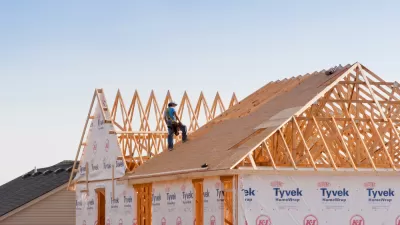Since the Great Recession, homeownership is down and corporations are taking advantage of the profit opportunities.

"Just as high-priced condos in expensive cities have become a new kind of asset for large companies and wealthy foreigners, so too have larger and larger numbers of single-family homes been turned into investment vehicles for large corporations," writes Richard Floria.
A new working paper from the National Bureau of Economic Research shows that one of the outcomes of the Great Recession was a decline in home ownership of 4 percent between 2007 and 2014, when private companies came in and acquired these properties. "This represents more than $220 billion in housing value—a huge transfer of wealth from Americans who once owned, or would have owned, these homes, to large corporations," says Florida.
These companies, notes Florida, are profiting both from rental incomes in cities with lower home prices and from the appreciation of properties in more expensive cities. "For a growing number of families, the American Dream of owning their own home and the wealth and financial security that comes from it have given way to renting a place to live from a mega-corporation."
FULL STORY: How Housing Wealth Transferred From Families to Corporations

Planetizen Federal Action Tracker
A weekly monitor of how Trump’s orders and actions are impacting planners and planning in America.

Congressman Proposes Bill to Rename DC Metro “Trump Train”
The Make Autorail Great Again Act would withhold federal funding to the system until the Washington Metropolitan Area Transit Authority (WMATA), rebrands as the Washington Metropolitan Authority for Greater Access (WMAGA).

DARTSpace Platform Streamlines Dallas TOD Application Process
The Dallas transit agency hopes a shorter permitting timeline will boost transit-oriented development around rail stations.

Renters Now Outnumber Homeowners in Over 200 US Suburbs
High housing costs in city centers and the new-found flexibility offered by remote work are pushing more renters to suburban areas.

The Tiny, Adorable $7,000 Car Turning Japan Onto EVs
The single seat Mibot charges from a regular plug as quickly as an iPad, and is about half the price of an average EV.

Supreme Court Ruling in Pipeline Case Guts Federal Environmental Law
The decision limits the scope of a federal law that mandates extensive environmental impact reviews of energy, infrastructure, and transportation projects.
Urban Design for Planners 1: Software Tools
This six-course series explores essential urban design concepts using open source software and equips planners with the tools they need to participate fully in the urban design process.
Planning for Universal Design
Learn the tools for implementing Universal Design in planning regulations.
Municipality of Princeton
Roanoke Valley-Alleghany Regional Commission
City of Mt Shasta
City of Camden Redevelopment Agency
City of Astoria
Transportation Research & Education Center (TREC) at Portland State University
US High Speed Rail Association
City of Camden Redevelopment Agency
Municipality of Princeton (NJ)





























